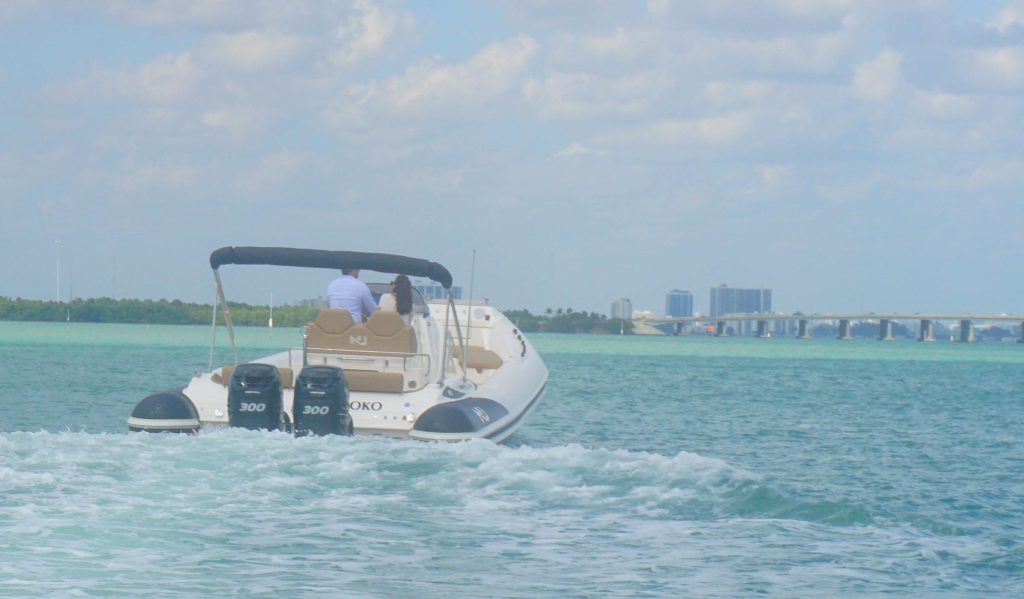L’uso corretto del trim ha come diretta conseguenza quella di far navigare la barca con assetto corretto, quindi più veloce e soprattutto più sicura. E cosa non secondaria, ottimizzando i consumi.
Purtroppo è uno strumento spesso ignorato dai diporitisti meno esperti. L’argomento è vasto e si presta a considerazioni che attengono alle diverse condizioni della navigazione prima fra le quali lo stato del mare.
Innanzitutto stabiliamo subito quale effetto abbia l’uso del trim. Se diamo trim positivo, ossia lo alziamo, la spinta dei fuoribordo si esercita verso il basso, con il risultato di far alzare la prua. Se viceversa portiamo il trim in negativo, quindi abbassiamo i fuoribordo, la spinta sarà esercitata verso l’alto con il risultato di far abbassare la prua.
Stabilita questa regola generale, dobbiamo capire come e in quali condizioni sia più opportuno dare trim negativo o positivo. Per praticità possiamo stabilire qualche altra regola generale la cui applicazione va interpretata alla luce delle condizioni che troviamo in quel dato momento in mare.
Quando diamo trim positivo alleggeriamo il carico a prua, limitando la parte bangata e che offre resistenza, da centro barca fino a poppa. In queste condizioni si tende ad avere maggiore velocità e minore consumo rispetto alla condizione in cui ci troviamo quando diamo trim negativo , abbassando la prua e quindi navigando con più scafo bagnato, maggiore resistenza, minore velocità e più consumi. Inoltre, con la prua troppo carica, ossia con i trim troppo negativi, lo scafo risentirà di più degli effetti delle onde.
Un’abitudine che abbiamo acquistato nel tempo è quella di partire con i trim negativi, se non al 100% almeno al 50% e regolare poi l’assetto che reputiamo più opportuno. Non si tratta certo di una regola ma semplicemente di una nostra preferenza che non si è certo obbligati ad osservare.
Ora vediamo di applicare queste regolette a condizioni pratiche che come vedremo introducono qualche variabile. Se per esempio stiamo navigando con onda formata, diciamo di circa un metro, e probabilmente anche con vento, dobbiamo trovare un giusto compromesso. La regola teorica vorrebbe che tenessimo lo scafo con la prua più alta quindi trim positivi, per ridurre la superficie soggetta all’effetto dell’onda. Ma dobbiamo tenere presente anche l’azione del vento, soprattutto se è forte di prua. In questo caso allora, dare trim negativo del 30% può essere un buon compromesso. Lo scafo sarà bagnato da circa i 3/4 della sua lunghezza verso poppa.
Con meno onda, diciamo circa mezzo metro e meno vento, possiamo portare il trim verso una posizione neutra, scaricando un po’ la prua e riducendo così la parte bagnata e quindi la resistenza.
Infine, con mare piatto, possiamo scegliere di dare trim positivo anche al massimo scaricando completamente la prua e riducendo al minimo la parte bagnata ottenendo, a parità di giri, il massimo della velocità con l’ottimizzazione dei consumi.
Come detto si tratta di regole generali dettate solo dall’intenzione di schematizzare gli effetti dell’uso del trim. In ogni caso, fatte le dovute considerazioni relative al tipo di scafo che abbiamo e alle condizioni meteomarine, la cosa importante è quella di avere idea di quali effetti il trim produca sulla nostra navigazione e di non lasciarlo inutilizzato.













